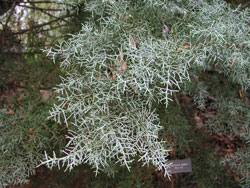Resource Library
Plant of the Week: Cypress, Arizona
The University of Arkansas System Division of Agriculture does not promote, support or recommend plants featured in "Plant of the Week." Please consult your local Extension office for plants suitable for your region.
Plant of the Week
Arizona Cypress
Latin: Cupressus arizonica var. glacuca

Wintertime scenes can be a bit bland in many gardens if there is an overdependence on deciduous plants. Evergreens help liven the winter scene, but even then, something is needed to contrast the very greenness of these plants. One such contrast plant worth considering is the Arizona cypress, Cupressus arizonica var. glacuca.
Arizona cypress is a conical growing evergreen tree of the cypress family capable of reaching 50 feet in height with a spread of 30 feet, but in landscape situations it seldom exceeds half that size. As the trees begin growing, the bark is peeled off annually, revealing bright orange strips. On older trees the peeling stops and the bark becomes smooth.
The commonly cultivated forms have glaucous blue-gray foliage that is comprised of tiny V-shaped needles closely pressed to the stem to form a four-sided rope. The small branches branch irregularly, giving the tree a kind of open look when viewed close-up, instead of the compact look of a juniper. Seeds are borne in a round cone about an inch across.
Arizona cypress is native to regions of the desert southwest, where rainfall averages between 15 and 20 inches per year. It ranges from lowland areas to up to 5,000 feet in some parts of Arizona. Though centered in Arizona, natural stands are found in California, Utah, New Mexico and the Big Bend region of Texas.
I think of the Arizona cypress as a desert plant, though in reality it grows in an area having a monsoonal climate. That is, dry most of the year with much of the rainfall coming during the summer as random summer thunderstorms. To assume that such a plant would grow in a wetter climate seems unlikely, but they actually do grow in most of the southeastern states as long as the temperature doesn’t drop below zero in winter. But though they are trouble-free as young plants, making about a foot of growth a year, they often die inexplicably when they reach mature stature in 20 or 30 years.
Arizona cypress plants found in nurseries are now mostly vegetatively propagated clones selected for the dense coat of wax on their leaves. ‘Blue Ice,’ ‘Blue Pyramid’ and ‘Silver Smoke’ are clones that are occasionally met within nurseries. ‘Blue Ice,’ a clone discovered in the 1960s by a New Zealand nurseryman, is probably the most common.
The Arizona cypress is a good addition to a screen planting, where it can be mixed with other evergreen plants to create a pleasing wintertime effect. It can also be used as a lone specimen, where its conical form will make a striking display. It should have full sun, good wintertime drainage and be allowed to fend for itself. Irrigated beds tend to hasten the occurrence of root rot problems.
By: Gerald Klingaman, retired
Extension Horticulturist - Ornamentals
Extension News - April 2, 2010
The University of Arkansas System Division of Agriculture does not maintain lists of retail outlets where these plants can be purchased. Please check your local nursery or other retail outlets to ask about the availability of these plants for your growing area.